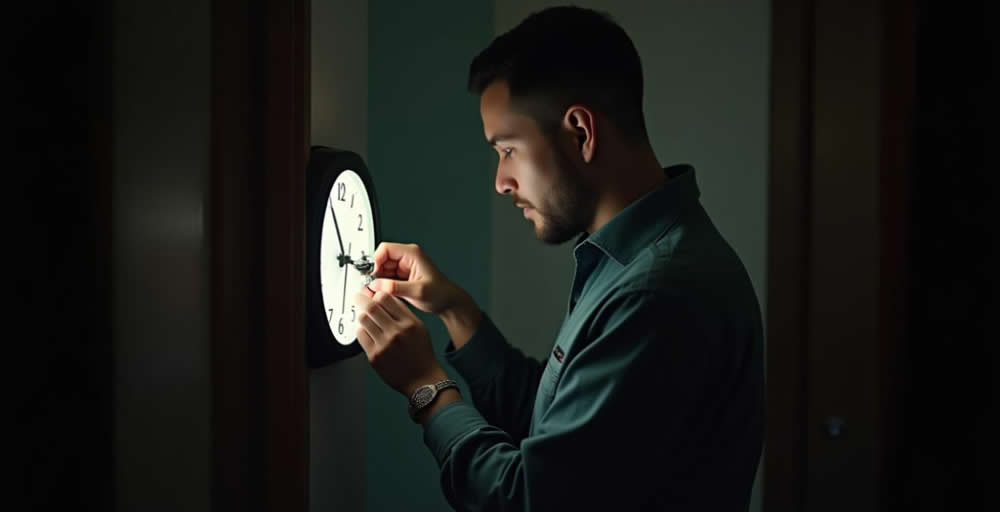
Secrets Behind Corporate Bug Sweeping
If you picture bug sweeping as a scene from a spy thriller, someone in black scanning walls with a gadget that beeps ominously, you’re not alone. But in the real world a day in the life of a Technical Surveillance Counter-Measures (TSCM) specialist looks very different. Few flashing lights or dramatic discoveries. It’s much more about patience and precision.
A bug sweep is a mix of scientific and detective work. The tools may be extremely high-tech, but it’s actually the operator’s training and intuition that make them effective. A TSCM specialist must notice every signal spike or misplaced wire and uncover the story they might tell. Some days, that story ends with little fanfare: no threat found. But other days, it finishes with the quiet removal of a planted device.
Here’s what a real day in their world looks like, from that first coffee-fueled checklist to the last packed-away case at dusk.
Early Start, Quiet Prep
The workday begins for most people when the office fills with chatter and the buzz of electronic devices. But for a bug-sweeping professional, the real work happens in the quiet hours, long before anyone else arrives or after the last person leaves. The stillness is convenient, but it’s also necessary. Routers can be unplugged and Wi-Fi signals muted without disrupting anyone’s workflow.
A typical morning starts with a briefing. Most jobs have a story behind them. Sometimes, clients may have had a suspected data leak. Other clients might have had too many boardroom conversations find their way outside company walls. The sweeper studies the layout, highlights sensitive zones, and notes anything unusual. This is where experience counts: knowing which corners tend to attract trouble and which devices deserve a second look.
Preparation is more than busywork; it’s a strategy. A good sweep goes beyond waving gadgets around and hoping for a blip; you need to do the legwork to know why you’re scanning a particular area and what you’re looking for. Every successful operation starts here, in the quiet before the work begins.
First Step: Baseline Observation
Before a sweeper uses any tools, they typically will start by taking a slow, deliberate walk through the site. They’re scanning walls, but also watching how the environment breathes.
- Are vents positioned near confidential meeting spaces?
- Did someone leave a personal device charging on a desk?
- Do visitors linger near reception longer than they should?
These observations help form a "mental map” of the space and its routines. Habits, after all, are where vulnerabilities hide. Understanding the day-to-day goings-on of an office makes the sweeper’s job easier and more effective.
The Quick Lens Scan
Before starting a full sweep, a specialist will inspect the space using an optical lens finder. It’s fast and effective at spotting both active and dormant hidden cameras.
The tool casts a ring of light into the room. Any glass camera lens in the room will reflect the light as a sharp pinpoint, even if it’s hidden in a smoke detector or a picture frame. A few passes with a hidden-camera lens detector(1) can uncover surprises that would take much longer to find by hand.
Creating a "Quiet” RF Environment
Modern offices are full of legitimate transmitters: Wi-Fi routers, Bluetooth devices, and mobile phones. These can mask or distract from real threats. That’s why part of the sweeper’s job is to create an RF-quiet environment. The network is shut down. Cordless phones are unplugged. Staff are asked to leave their devices outside the sweep area. With the noise reduced, any rogue signal becomes easier to spot.
RF and Optical Checks: Essential Tools for Bug Sweeping
With the airwaves quiet, the sweeper turns to a spectrum analyzer(2). This is the heart of the search for active transmitters.
The device scans the radio spectrum, from low-frequency signals to high-band wireless. Anything unusual—a spike, a hidden carrier wave, a burst transmission—is investigated.
A trained sweeper knows what "normal” looks like in an RF trace. They can tell a harmless Wi-Fi beacon from a disguised GSM bug sending audio to a remote listener.
Hands-On Search: Finding Dormant Devices During Bug Sweeps
Not every threat is broadcasting. Some devices store recordings locally or switch on only when triggered. That’s when the sweeper moves to a hands-on search.
They’ll check:
- Under conference tables.
- Inside plant pots.
- Behind wall clocks.
- Under desk drawers.
A flashlight, an inspection mirror, and patience are the primary tools here.
Finding the Dormant Devices
For silent electronics, the sweeper uses a non-linear junction detector(3). It detects the semiconductor junctions found in most electronic circuits—powered or not.
This is the tool that finds a dead recorder inside a power strip or a switched-off bug hidden in a ceiling panel. It doesn’t care if the device is transmitting; if it’s there, the NLJD will find it.

Ceiling and High-Access Checks
Some of the hardest bugs to find are above eye level in light fixtures or ceiling tiles.
To reach them, a sweeper can use a telescoping pole with an attached NLJD or optical detector. This allows them to scan without having to take large sections of the ceiling apart. It’s a massive time saver and avoids unnecessary disruption.
The Portable Kit Advantage
A portable RF & lens detection kit(4) is a foundational necessity of a good bug sweeper’s toolbox. The best kits combine RF detection, optical scanning, and other essentials in a single case. It makes it easy to transition between different environments; for example, a boardroom in the morning and a hotel room in the afternoon.
Debrief and Reporting
Once the last signal check is done the most important part of the job, the debrief, begins. The sweeper meets with the client to walk them through findings.
If something was discovered, the sweeper explains what it was, where it was found, and how it worked. Uncovered devices are documented and safely removed for more analysis. For the client, this transparency builds trust.
But when the sweep turns up clean (which is fortunately often the case) the focus shifts from detection to prevention. Together, they’ll talk through practical next steps:
- Limiting who has access to sensitive areas.
- Securing fixtures like clocks or smoke detectors that could conceal small devices.
- Using conversation-masking tools for confidential, high-level meetings.
The ultimate goal is to make the space breach-proof. So, a good debrief doesn’t just end the sweep, it strengthens the organization’s defenses for the next quarter and beyond.
From the outside, a sweep might look like a series of steps: scan, search, pack up. But each site is different. Some offices are clean but sloppy with access control. Others are locked down but full of cheap electronics that create RF clutter.
A good sweeper adapts. They decide when to focus on RF, when to dig into vents, and when to spend extra time on a single suspicious object. This judgment is what separates an amateur with a detector from a trained professional.
How Can I Become a Bug Sweeper?
There’s no single university degree that turns you into a bug-sweeping expert. Most professionals in Technical Surveillance Counter-Measures (TSCM) come from backgrounds in law enforcement, military intelligence, cybersecurity, or electronics engineering. That said, there are specialized training programs—often run by security academies or private counter-surveillance firms—that cover:
- RF theory and spectrum analysis
- Non-linear junction detection
- Optical and thermal detection methods
- Physical search techniques
- Legal considerations for surveillance detection
Many sweepers also maintain security clearances and keep their skills fresh through manufacturer training for the latest gear, such as the Delta X series or EDD-24T devices. Certifications from organizations like the Espionage Research Institute International (ERII) or the Technical Surveillance Counter Measures Institute (TSCMi) can also boost credibility.
Training and Career: Becoming an Expert in Bug Sweeps
TSCM is a niche but growing field. Rising concerns about corporate espionage, IP theft, and political spying mean more companies are adding regular sweeps to their security protocols. Opportunities exist in:
- Private security firms that specialize in corporate or VIP protection
- In-house corporate security teams for large multinationals
- Government agencies tasked with protecting sensitive facilities
- Independent consultancy for those with the experience and equipment to go solo
The best career stability comes from building long-term client relationships, as many sweeps are scheduled on a quarterly or bi-annual basis.
How Much a Bugsweeper Makes
Bug sweeping isn’t an entry-level job, and the pay reflects that. Salaries and fees vary widely depending on location, experience, and whether you’re an employee or independent contractor:
- Entry-level with training: €40,000–€55,000 per year in Europe / $45,000–$60,000 in the US
- Experienced corporate or government sweeper: €60,000–€90,000+ per year / $70,000–$100,000+ in the US
- Independent consultant: Often charge €1,000–€3,000 per day for sweeps, with rates rising for high-risk or overseas assignments
Specialists who can combine technical skill with discretion and client trust often secure premium contracts, especially in industries like finance, law, and defense where a single breach can cost millions.
Conclusion
A bug sweep isn’t about drama; it’s about discipline. It’s long hours of quiet work, often in empty rooms, with the occasional jolt of finding something that shouldn’t be there. For a corporate client, that discipline means peace of mind.
Whether it’s an urgent investigation or a regular quarterly check, the tools and methods are the same: observe, isolate, search, verify. And while you can buy the same gear the pros use, the real secret is knowing how and when to use it.
Protect your business with the same equipment trusted by professionals. Explore our full Counter Surveillance Collection at SpyShopEurope.com.
Frequently Asked Questions
Do bug sweepers need a license?
Can anyone buy bug-sweeping equipment?
How long does a typical bug sweep take?
How often should a business schedule a sweep?
DIY sweep vs hiring a professional?
How much does it cost to hire a bug sweeper?
Can sweeps find hidden cameras as well as microphones?
References
- Hidden-camera lens detector — reveals lenses via retro-reflection. View product
- Spectrum analyzer — monitors RF spectrum to identify active transmissions. View product
- Non-linear junction detector (NLJD) — locates dormant or powered-off electronics. View product
- Portable RF & lens detection kit — consolidated toolkit for room checks. View product
Damir First
CEO of SpyShopEurope.com
Request a custom quote for a personalized recommendation.




